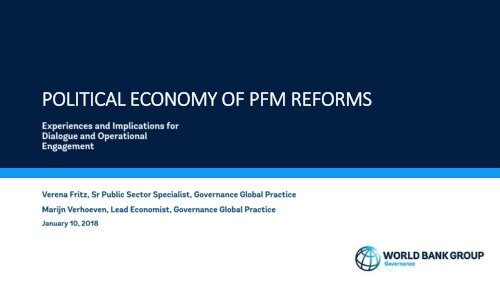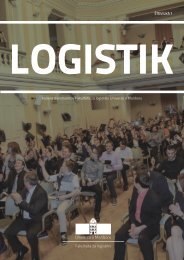The World Bank's 'Political Economy of PFM Reforms' Book Launch Presentation
The book launch presentation on
The book launch presentation on
- No tags were found...
Create successful ePaper yourself
Turn your PDF publications into a flip-book with our unique Google optimized e-Paper software.
POLITICAL ECONOMY OF <strong>PFM</strong> REFORMS
million USD<br />
Motivation: why take a fresh look at <strong>PFM</strong> reforms?<br />
• Using fiscal resources well is critical for equitable<br />
development<br />
• Many countries have engaged on <strong>PFM</strong> reforms, and they have<br />
also attracted substantial donor resources<br />
• While the technical reform approaches are similar across<br />
many countries, actual progress and impact seems to differ<br />
• General notion that non-technical drivers matter, but little<br />
systematic evidence <strong>of</strong> what these are and how they affect<br />
progress & impact<br />
• Intention <strong>of</strong> this work is to<br />
• Take the discussion on <strong>PFM</strong> reforms into some new directions – also in<br />
light <strong>of</strong> the 2017 WDR<br />
• Provide empirical evidence and a suggested framework for how to look<br />
at non-technical drivers<br />
• Tease out operational implications from the available evidence<br />
400.0<br />
• No assumption to be able to provide all the answers through<br />
200.0<br />
one study 0.0<br />
2000.0<br />
1800.0<br />
1600.0<br />
1400.0<br />
1200.0<br />
1000.0<br />
800.0<br />
600.0<br />
ODA for public financial management reforms<br />
2002 2003 2004 2005 2006 2007 2008 2009 2010 2011 2012 2013 2014 2015
Approach taken to explore non-technical drivers<br />
• Statistical analysis:<br />
• Covers 117 countries for which PEFA data was available, cross-checking with CPIA 13<br />
• Looks at descriptives and at correlations with characteristics across countries as well as ‘first<br />
difference’, testing for a range <strong>of</strong> demographic, political, and economic factors (next slide)<br />
• Case studies:<br />
Tracking evolution <strong>of</strong> <strong>PFM</strong> reforms and political<br />
economy drivers over past ca 10 years<br />
• Five cases covered: Georgia, Nepal, Nigeria,<br />
Philippines, Tanzania<br />
• Plus a case-study framework, included as an<br />
annex in the report
While some countries have progressed, still more gains to be made<br />
PEFA by region<br />
Revenue<br />
Budget<br />
Credibility<br />
4<br />
3<br />
2<br />
Comprehensiv<br />
eness and<br />
Transparency<br />
Revenue<br />
External<br />
Scrutiny and<br />
Audit<br />
Accounting<br />
and<br />
Reporting<br />
Budget<br />
Credibility<br />
4<br />
3<br />
2<br />
1<br />
Predictabilit<br />
y/Control <strong>of</strong><br />
Budget<br />
Execution<br />
LIC LMIC UMIC<br />
PEFA by income group<br />
Comprehens<br />
iveness and<br />
Transparenc<br />
y<br />
Policy-based<br />
Budgeting<br />
4<br />
CPIA 13 -- regional and income group average performance<br />
External<br />
Scrutiny and<br />
Audit<br />
1<br />
Policy-based<br />
Budgeting<br />
3.5<br />
3<br />
Accounting<br />
and Reporting<br />
Predictability/<br />
Control <strong>of</strong><br />
Budget<br />
Execution<br />
EAP ECA LAC MENA SAR SSA<br />
2.5<br />
2<br />
1.5<br />
1<br />
LAC SAR EAP SSA MENA ECA LIC LMIC UMIC SIDS Global<br />
2001 (average) 2007 (average) 2014 (average)
Statistical Analysis – main findings<br />
• Factors tested:<br />
• [economic] GDP per capita and GDP growth, fiscal crisis, natural resource dependency,<br />
• [demographic] population, SIDS,<br />
• [sources <strong>of</strong> revenue] aid dependency, own revenue to GDP ratio,<br />
• [political and institutional] political stability, political regime, presence <strong>of</strong> programmatic parties<br />
• All factors combined explain about 40% <strong>of</strong> variation in <strong>PFM</strong> performance<br />
• As intuitive, countries that have higher income levels tend to have better <strong>PFM</strong><br />
• the fit is not very close – i.e. many countries perform far from the trend-line<br />
• Apart from GDP per capita levels, the main & most robust factors are<br />
• (i) high dependency on natural resources (negative), (ii) being a Small Island Developing State<br />
(SIDS) (negative), (iii) recent GDP per capita growth (positive)<br />
• weaker and/or less robust relationships: population size, having programmatic parties, political<br />
stability, and regime type<br />
• levels <strong>of</strong> revenue and ODA relative to GDP are not significant<br />
Correlations, not causal<br />
Non-correlation can mean a total non-relationship, or can also be associated that in<br />
some countries factor x was associated with reforms, while in others, it was not
1.5<br />
1.5<br />
2<br />
2.5<br />
Most Recent PEFA Score<br />
2<br />
2.5<br />
3<br />
3<br />
3.5<br />
3.5<br />
Relationship with GDP per capita – and dispersion<br />
earliest PEFA available<br />
most recent PEFA data available<br />
ETH<br />
MOZ<br />
NER<br />
LBR<br />
ZAR<br />
BDI<br />
MWI<br />
CAF<br />
<strong>PFM</strong> Quality and Income<br />
ZAF<br />
BRA<br />
PER MUS<br />
CRI<br />
BTN<br />
TUR<br />
ARM SLV<br />
JOR TUN<br />
COL<br />
MAR<br />
BLR THA<br />
MDA<br />
NAM<br />
GEO<br />
GRD<br />
KAZ<br />
BFA<br />
IND<br />
MNE<br />
ALB<br />
DZA<br />
TZA<br />
BWA<br />
WSM AZE<br />
KSV UKR SRB<br />
PAK PRY DMA<br />
VCT EGY<br />
RUS<br />
JAM<br />
KEN VUT<br />
GTM<br />
NIC<br />
IDN<br />
RWASLE TMP MDG ZMB KHM<br />
GUY<br />
UGA<br />
MLI<br />
NPL<br />
MRT<br />
LCA<br />
TJK CMR<br />
TON PHL<br />
ECU MDV<br />
GMB SEN<br />
BEN<br />
DOM<br />
BGD<br />
AFG<br />
GAB<br />
KGZ<br />
WBG<br />
SLBKIR<br />
TCD PNG CIV SDN<br />
SWZ<br />
FJI<br />
SUR<br />
TUV COG<br />
GIN<br />
TGO<br />
BLZ IRQ<br />
GNBCOM<br />
LBR<br />
ZAR NER BDI<br />
CAF<br />
MOZ<br />
MWI<br />
<strong>PFM</strong> Quality and Income<br />
ETH<br />
BFA RWA<br />
MLI<br />
AFG<br />
NPL<br />
TMP<br />
UGA<br />
TJK<br />
TZA<br />
GMBSLB<br />
SLE<br />
KENCIV<br />
ZWE<br />
KHM<br />
SEN<br />
GHA<br />
TUV<br />
GIN TGO<br />
MDG<br />
COM<br />
HTI<br />
BEN LSO<br />
PNG<br />
KGZ<br />
ZMB<br />
BGD<br />
STP VUT<br />
LAO MRT<br />
FSM SSD<br />
MHL<br />
MDA<br />
GEO<br />
BTN<br />
ARM<br />
KSV<br />
ALB<br />
AZE<br />
MAR<br />
CRI<br />
PHL IDN ECU<br />
UZBHND<br />
MNE<br />
PAK<br />
TUNMKD<br />
BWA<br />
SLV UKR COL SRB<br />
NIC VNM<br />
MNG<br />
JOR<br />
PRY<br />
MUS<br />
WSM<br />
LKA<br />
BLR<br />
TON<br />
DOM<br />
GTM NAM<br />
BOL<br />
WBG<br />
NGA<br />
COG<br />
SWZ JAM DMA<br />
GRD<br />
VCT<br />
BLZ<br />
PER<br />
LCA<br />
MDV<br />
ZAF<br />
PAN<br />
SURGAB<br />
6 7 8 9 10<br />
Log GDP per capita (PPP, lagged 5-year average)<br />
EAP ECA LAC MENA SAR SSA<br />
6 7 8 9 10<br />
Log GDP per capita (PPP, lagged 5-year average)<br />
EAP ECA LAC MENA SAR SSA
Cross-country correlation results (all available PEFA reports, excluding HICs)<br />
(1) (2) (3) (4) (5) (6)<br />
GDP per capita (log) 0.2378*** 0.1958*** 0.2568*** 0.2171*** 0.2052*** 0.1887***<br />
(0.0403) (0.0495) (0.0580) (0.0391) (0.0387) (0.0489)<br />
Growth (per capita) 0.0276** 0.0335*** 0.0242** 0.0223** 0.0285*** 0.0317***<br />
(0.0115) (0.0096) (0.0116) (0.0106) (0.0099) (0.0112)<br />
Population (log) 0.0411* 0.0579** 0.0481* 0.1085*** 0.0502** 0.0259<br />
(0.0232) (0.0241) (0.0255) (0.0288) (0.0228) (0.0277)<br />
SIDS −0.2223* −0.1728 −0.2216* −0.2967*** −0.3336*** −0.2480*<br />
(0.1225) (0.1295) (0.1242) (0.1087) (0.1142) (0.1253)<br />
Resource −0.3386*** −0.3498*** −0.3342*** −0.3542*** −0.2777*** −0.2918***<br />
(0.0911) (0.0864) (0.0931) (0.0841) (0.0881) (0.0911)<br />
Tax 0.0106<br />
(0.0074)<br />
Aid 0.0017<br />
(0.0037)<br />
Political Stability 0.0867***<br />
(0.0212)<br />
Regime 0.0487***<br />
(0.0159)<br />
Programmatic parties 0.4791***<br />
(0.1639)<br />
Observations 262 244 258 252 256 231<br />
R-squared 0.340 0.384 0.344 0.436 0.386 0.351
Case Studies: five different experiences with <strong>PFM</strong> reforms<br />
Georgia – 2008 and 2013 Nepal – 2008 and 2014 Nigeria – 2012 (not <strong>of</strong>ficially endorsed)<br />
External<br />
Scrutinity and<br />
Audit<br />
Accounting<br />
and Reporting<br />
Budget<br />
Credibility<br />
4<br />
3<br />
2<br />
1<br />
Predictability/<br />
Control <strong>of</strong><br />
Budget<br />
Execution<br />
External<br />
Scrutinity and<br />
Audit<br />
Comprehensiv<br />
eness and<br />
Transparency<br />
Policy-based<br />
Budgeting<br />
Philippines – 2010 and 2016<br />
Budget<br />
Credibility<br />
4<br />
3<br />
2<br />
External<br />
Scrutinity and<br />
Audit<br />
Accounting<br />
and Reporting<br />
Comprehensive<br />
ness and<br />
Transparency<br />
Budget<br />
Credibility<br />
4<br />
3<br />
2<br />
1<br />
Predictability<br />
/Control <strong>of</strong><br />
Budget<br />
Execution<br />
Comprehensi<br />
veness and<br />
Transparency<br />
Policy-based<br />
Budgeting<br />
External<br />
Scrutiny and<br />
Audit<br />
Accounting and<br />
Reporting<br />
Tanzania – 2006, 2009, 2010, 2013<br />
External<br />
Scrutiny and<br />
Audit<br />
Budget<br />
Credibility<br />
4.0<br />
3.0<br />
2.0<br />
Budget<br />
Credibility<br />
4<br />
3<br />
2<br />
1<br />
Comprehensiv<br />
eness and<br />
Transparency<br />
Predictability <strong>of</strong><br />
Budget<br />
Execution<br />
Comprehensiven<br />
ess and<br />
Transparency<br />
Policy Based<br />
Budgeting<br />
1<br />
1.0<br />
Accounting and<br />
Reporting<br />
Policy-based<br />
Budgeting<br />
Accounting<br />
and Reporting<br />
Policy Based<br />
Budgeting<br />
Predictability/C<br />
ontrol <strong>of</strong> Budget<br />
Execution<br />
Predictability<br />
<strong>of</strong> Budget<br />
Execution
So, what’s the story behind those diverging trends in <strong>PFM</strong> performance?<br />
Chapter 3 – ‘the big picture’/overall political commitment<br />
Chapter 4 – institutions, ideas, demand<br />
Chapter 5 – specific reform efforts across the budget cycle/<strong>PFM</strong> areas<br />
Chapter 6 – implications for operational approaches and policy dialogue<br />
Institutions,<br />
ideas,<br />
demand<br />
‘Big picture’<br />
incentives/<br />
political<br />
commitment<br />
<strong>PFM</strong> reform<br />
plans and<br />
specific<br />
efforts<br />
Refining our approaches to supporting <strong>PFM</strong> reforms<br />
<strong>PFM</strong> performance changes
Potential drivers <strong>of</strong> political commitment to <strong>PFM</strong> reforms<br />
From the perspective <strong>of</strong> politicians, <strong>PFM</strong> reforms are a means to an<br />
end, rather than an end in itself – so understanding the main highlevel<br />
policy goals also matters for anticipating reform commitment<br />
• Looking at a set <strong>of</strong> key drivers:<br />
• electoral pledges made, strength <strong>of</strong> mandate, and readiness to pursue<br />
reforms<br />
• overarching policy goals<br />
• need to react to fiscal trends<br />
• Interacting with the institutional set-up and interests in influencing<br />
opportunities for reform
Key ingredients <strong>of</strong> political commitment and readiness for reforms<br />
Georgia Nepal Nigeria Philippines Tanzania<br />
Election year 2004 2008 2007 2010 2005<br />
Electoral pledge to<br />
reform?<br />
+++<br />
Commitment to<br />
overhaul the state<br />
++<br />
Commitment mainly<br />
to greater inclusion<br />
+<br />
‘National unity’ and<br />
stability focused<br />
+++<br />
Anti-corruption and<br />
poverty reduction<br />
+ to ++<br />
Limited commitment<br />
to change<br />
Strength <strong>of</strong> electoral<br />
mandate<br />
+++<br />
Exceptionally strong<br />
+<br />
Weak – highly<br />
fragmented, resulting<br />
in high gov’t turnover<br />
++<br />
Strong (70-80%), but<br />
allegations <strong>of</strong> fraud &<br />
president falling ill<br />
+ to ++<br />
Medium (42%<br />
president)<br />
++<br />
Strong (80%)<br />
Preparedness for<br />
reforms & technical<br />
expertise<br />
++<br />
Several ministers had<br />
gathered initial<br />
experience during the<br />
previous<br />
administration<br />
+ to ++<br />
Former rebels<br />
Relatively good<br />
technical expertise in<br />
the bureaucracy<br />
+ to ++<br />
Technical expertise<br />
good, reform plans<br />
‘hang-over’ from HIPC<br />
effort<br />
++<br />
Well trained and<br />
experienced<br />
Secretary <strong>of</strong> Budget,<br />
plan to make Gov’t<br />
much more<br />
transparent<br />
+ to ++<br />
Donor-driven reform<br />
plans<br />
Technical expertise<br />
and experience with<br />
<strong>PFM</strong> reforms since<br />
late 1990s
2000<br />
2000<br />
2001<br />
2001<br />
2002<br />
2002<br />
2003<br />
2003<br />
2004<br />
2004<br />
2005<br />
2005<br />
2006<br />
2006<br />
2007<br />
2007<br />
2008<br />
2008<br />
2009<br />
2009<br />
2010<br />
2010<br />
2011<br />
2011<br />
2012<br />
2012<br />
2013<br />
2013<br />
2014<br />
2014<br />
2015<br />
2015<br />
2016<br />
2016<br />
2000<br />
2001<br />
2002<br />
2003<br />
2004<br />
2005<br />
2006<br />
2007<br />
2008<br />
2009<br />
2010<br />
2011<br />
2012<br />
2013<br />
2014<br />
2015<br />
2016<br />
2000<br />
2001<br />
2002<br />
2003<br />
2004<br />
2005<br />
2006<br />
2007<br />
2008<br />
2009<br />
2010<br />
2011<br />
2012<br />
2013<br />
2014<br />
2015<br />
2016<br />
2000<br />
2001<br />
2002<br />
2003<br />
2004<br />
2005<br />
2006<br />
2007<br />
2008<br />
2009<br />
2010<br />
2011<br />
2012<br />
2013<br />
2014<br />
2015<br />
2016<br />
Fiscal trends, elections, and timing <strong>of</strong> reform episodes<br />
Georgia<br />
Nepal<br />
Nigeria<br />
40<br />
35<br />
30<br />
25<br />
20<br />
15<br />
10<br />
5<br />
0<br />
Start <strong>of</strong> new Gov’t<br />
40<br />
35<br />
30<br />
25<br />
20<br />
15<br />
10<br />
5<br />
0<br />
2006 Peace agreement<br />
40<br />
35<br />
30<br />
25<br />
20<br />
15<br />
10<br />
5<br />
2007<br />
Yar’Adua<br />
elected<br />
Buhari Gov’t elected,<br />
starts moving <strong>PFM</strong><br />
and tax reforms<br />
forward<br />
0<br />
Revenue (incl grants)<br />
Expenditure<br />
Revenue (incl grants)<br />
Expenditure<br />
Tanzania<br />
Philippines<br />
Revenue (incl grants)<br />
Expenditure<br />
40<br />
Earlier fiscal<br />
35<br />
stress & reforms<br />
30<br />
25<br />
20<br />
15<br />
10<br />
5<br />
0<br />
2005<br />
elections<br />
40<br />
35<br />
30<br />
25<br />
20<br />
15<br />
10<br />
5<br />
0<br />
2010 elections<br />
<strong>of</strong> a reformoriented<br />
gov’t<br />
Revenue (incl grants)<br />
Expenditure<br />
Revenue (incl grants)<br />
Expenditure
Relevant implications<br />
Opportunities for transformative progress exist, but are rare<br />
• Opportunities vary substantially by context<br />
• Different approaches relative to context: preparing the ground/moving incrementally<br />
forward/limiting back-sliding; or pursuing more transformative opportunities –<br />
subject to changes over time<br />
Windows <strong>of</strong> opportunity are important but typically short<br />
• <strong>The</strong>y may last 1, 2, maybe 3 years<br />
• Flexible (and agile) engagement is critical for providing rapid support – with<br />
implications for the time to prepare projects, and also the likely need to restructure<br />
‘up’ or ‘down’<br />
Some reform efforts are motivated by fiscal crises<br />
• Attention both to revenue and expenditure reforms is critical to reduce fiscal losses<br />
and accountability gaps on both sides<br />
• In a case like Nigeria, focusing on improved expenditure management alone would<br />
not address some <strong>of</strong> the biggest resource and accountability problems
Legal and institutional aspects<br />
• Are part <strong>of</strong> the conditions as well as target for reforms<br />
• Influence how easy/difficult it is to move reforms forward and to achieve functional<br />
improvements<br />
• Legal: Organic <strong>PFM</strong> legislation, External Audit, and Procurement<br />
• other legislation or regulations regarding PIM, SOEs<br />
• Institutional:<br />
• (i) organization <strong>of</strong> CFAs<br />
• (ii) executive-legislative relationship concerning (a) passage <strong>of</strong> annual budget laws,<br />
(b) review <strong>of</strong> audit reports, and (c) passage <strong>of</strong> pertinent reform legislation<br />
• Other aspects such as the clarity <strong>of</strong> intergovernmental roles and responsibilities<br />
• Legal and institutional challenges can be linked: the same countries that<br />
have the most fragmented CFA functions (Nigeria and Philippines) also lack<br />
a comprehensive organic budget law
Parliaments play a broader<br />
and in some ways a worse role<br />
than expected<br />
Accountability<br />
function<br />
PI-26 [PI- 30]<br />
External audit<br />
PI-27 [PI-18] c<br />
Legislative<br />
<strong>of</strong> budgets<br />
PI-28 [PI-31]<br />
scrutiny<br />
Legislative scrutiny<br />
<strong>of</strong> audit reports<br />
Georgia Nepal Nigeria Philippines Tanzania<br />
2008 2013 2008 2015 2012 2010 2016 2006 2010 2013<br />
D+ B+ D+ C+ D+ B+ B<br />
[C+] b D+ B C+<br />
B+ A D+ D C+ C+ B+ C+ C+ B<br />
C+ D+ D+ D D D D C D+ D+<br />
→ External audit functions as such improve – but parliamentary follow-up remains a<br />
weak link<br />
Parliaments<br />
Budget<br />
approval<br />
function<br />
Approval <strong>of</strong><br />
<strong>PFM</strong> and<br />
related reform<br />
legislation<br />
Parliaments play a critical role when new organic<br />
budget laws are needed<br />
Long delayed budget approvals and negative impacts on budget execution esp in Nepal and Nigeria<br />
+ support for budget realism is important
<strong>PFM</strong> Legislation – current and pending<br />
Country Budget preparation and execution External audit Procurement<br />
Georgia Budget Code (2009) Audit Office (2008) Law on State Procurement (2010)<br />
Nepal Financial Procedures Act (1999)<br />
Audit Act (1991) Public Procurement Act (2007)<br />
Nigeria<br />
Philippines<br />
New Fiscal Responsibility and Budget<br />
Management Act under development<br />
Public Finance (Control and<br />
Management) Act (1958)<br />
Last attempt to pass a new law: 2009<br />
No unified <strong>PFM</strong> act<br />
Budget Reform Bill drafted and under<br />
discussion since 2015<br />
Audit Act (1957); Office <strong>of</strong> the Auditor<br />
General regulated by the 1999<br />
Constitution, adoption <strong>of</strong> separate law<br />
failed in the 2000s; re-submitted in<br />
2016<br />
No external audit act<br />
Public Procurement Law (2007)<br />
Government Procurement Reform Act<br />
(2003)<br />
Tanzania Public Finance Act (2001; revised 2004) Public Audit Act 2008 Public Procurement Act (2016;<br />
amending the Act <strong>of</strong> 2011)<br />
Three countries seeking new organic budget legislation: Nepal, Nigeria, and Philippines; also challenges with SAI laws<br />
All five countries adopted new procurement legislation within the last 10-15 years
Institutional arrangements influence level <strong>of</strong> reform challenge<br />
• Standard international ‘best-practice’ ideas: integrated CFA model -- varied reality & challenges<br />
‘fragmented/duplicative/idiosyncratic’<br />
Philippines:<br />
Department <strong>of</strong> Budget and<br />
Management<br />
Department <strong>of</strong> Finance –<br />
revenue policy and admin,<br />
debt<br />
Semi-autonomous Bureau <strong>of</strong><br />
Treasury<br />
National Economic<br />
Development Agency (NEDA)<br />
-- planning and PIM<br />
coordination functions<br />
Commission on Audit with<br />
overlapping accounting and<br />
external audit mandates<br />
Nigeria:<br />
- 2015: MOF as a ‘shell’:<br />
separate Budget Office,<br />
Office <strong>of</strong> the Accountant<br />
General, Debt Management<br />
Office, Planning Commission<br />
Since late 2015: new<br />
Ministry <strong>of</strong> Budget and<br />
National Planning; and<br />
separate Ministry <strong>of</strong> Finance<br />
Federal structure with<br />
limited role <strong>of</strong> federal gov’t<br />
Nepal:<br />
MOF responsible for budget<br />
preparation; plus oversight over<br />
semi-autonomous agencies:<br />
FCGO – treasury, semiautonomous<br />
PPMO – procurement<br />
NPC – planning/PIM; re-approves<br />
project plans <strong>of</strong> MDAs during<br />
implementation<br />
Revenue agencies (tax & customs)<br />
semi-autonomous under MOF<br />
Debt and aid management shared<br />
between MOF, FCGO, Central<br />
Bank<br />
Tanzania:<br />
Most main functions in<br />
MOF, but investment<br />
planning moved to<br />
Presidency (2008) and<br />
back to MOF (2015)<br />
Civil service pay in<br />
Presidency (Planning<br />
Commission + PSM)<br />
Intergovernmental fiscal<br />
relations in Prime<br />
Minister’s Office<br />
‘integrated’<br />
Georgia:<br />
Integrated Ministry <strong>of</strong><br />
Finance<br />
Full integration <strong>of</strong><br />
treasury functions and<br />
oversight <strong>of</strong> revenue<br />
functions introduced as<br />
part <strong>of</strong> reforms made<br />
since 2004<br />
Fluctuation in MOF’s role, scope, and capacities over time in most cases; influences where reform efforts are located<br />
& coordination
Relevant implications<br />
• Being clear about institutional<br />
arrangements and roles, and their impact<br />
• to assess likely difficulties, implications for<br />
<strong>PFM</strong> functionalities, as well as for identifying<br />
priorities for institutional changes<br />
• Especially where institutional changes appear<br />
essential – e.g. new laws, but also<br />
clarifying/improving accountability between<br />
levels <strong>of</strong> gov’t – it is critical to engage with<br />
stakeholders beyond MOF develop a vision<br />
and eventual compromise on reforms
Limited direct role <strong>of</strong> the demand side<br />
• Social dynamics have mattered for elections – i.e. the ‘long route’ <strong>of</strong><br />
accountability – that also feed into <strong>PFM</strong> reforms<br />
• Rose revolution (Georgia), Marxist/Maoist uprising (Nepal), election <strong>of</strong> more reform<br />
oriented president (Philippines in 2010; Nigeria and Tanzania in 2015)<br />
• Level <strong>of</strong> NGO interest in <strong>PFM</strong>/budgeting/procurement<br />
• Georgia – a few NGOs with a significant focus on procurement; particular issues such<br />
as civil service bonuses receive greater public attention<br />
• Nepal – civil society focused on bringing about greater equity; limited direct<br />
engagement with those driving <strong>PFM</strong> reforms; WB (and other international) support<br />
for community level budget literacy (PRAN)<br />
• Nigeria – NGOs interest is still recent, growing from EITI and stolen assets; NGOs at<br />
the state level face threats/dependent on the appetite <strong>of</strong> the governor;<br />
• Philippines – most active NGOs on budgeting and fiscal issues for the longest time;<br />
and close links with <strong>of</strong>fice holders, push for transparency and participatory budgeting<br />
– but the data that is being made public continues to be messy<br />
• Tanzania – active/established NGOs, some involved in sectoral PETS, but limited<br />
space given by gov’t prior to 2015; increasingly active media, focused on corruption<br />
cases; private sector focused on taxation issues
Implications<br />
• Given that citizen demand for <strong>PFM</strong> reforms is found to<br />
play a limited role in driving <strong>PFM</strong> reforms even in<br />
countries with relatively active civil society organizations –<br />
should we still engage?<br />
• Yes in principle, with a greater emphasis on:<br />
• a) recognizing the importance <strong>of</strong> the ‘long route’ <strong>of</strong> accountability<br />
• b) explaining and opening up <strong>PFM</strong> reforms to citizens/CSOs +<br />
promoting transparency that allows checking on how funds are<br />
managed + clarifying the distinction between better use <strong>of</strong> funds<br />
and getting more funds
Similarity/Uniformity <strong>of</strong> stated reform intentions<br />
Georgia Nepal Nigeria Philippines Tanzania<br />
MTEF √ √ (halted) √ √ Started since the late<br />
1990s, still in<br />
progress<br />
Program-based budgeting √ x x √ √<br />
Introducing TSA √ √ √ √ √<br />
FMIS √ √ √ √ Initial introduction in<br />
the late 1990s<br />
Introducing IPSAS √ √<br />
√ √ √<br />
Introducing<br />
e-procurement<br />
Introducing/strengthening<br />
internal audit<br />
Strengthening<br />
external audit<br />
(cash basis)<br />
√ √ x E-procurement<br />
introduced during<br />
earlier reform period;<br />
still work in progress<br />
√ √ √ √ √<br />
√ √ x √ √<br />
Partially in place at<br />
start <strong>of</strong> period<br />
Barely any reform that is not being pursued in each <strong>of</strong> the countries
But the ‘binding constraints’ actually vary<br />
• Variation in timeliness <strong>of</strong> budget approvals<br />
• Significant delays especially in Nepal and Nigeria, earlier in the Philippines<br />
• Cash management poses a major problem in some not in others<br />
• Affects how well line ministries and sub-national governments can rely on funds being<br />
released to them as planned<br />
• Major problem: Nigeria, more recently again in Tanzania<br />
• Intermediate: Nepal<br />
• Not a problem or resolved: Philippines, Georgia<br />
• Degree and quality <strong>of</strong> public finance transparency<br />
• E.g. Philippines publishes accounts, but the underlying accounting and reporting remains<br />
weak and fragmented<br />
• Importantly, uniformity in reform intentions appears more as a choice than an<br />
imposed ‘isomorphism’<br />
• International norms, standards, and networks play an important role – standards for<br />
reforms to accounting and audit, templates for budget preparation reforms
Partial, incomplete reforms are common<br />
• … but are not always clearly acknowledged as such<br />
• Common partial <strong>PFM</strong> reforms:<br />
• MTEFs used to define some broad goals, but not to firmly establish multi-year<br />
allocations<br />
• Many half-way TSAs<br />
• some accounts have been unified, others not<br />
• IT systems <strong>of</strong> which only some modules are used, or that are not as widely<br />
rolled out as originally intended to line ministries and sub-national levels, or<br />
which are only integrated for some aspects if at all<br />
• Program budgets as supplementary to line-item budgets<br />
• Partial reforms are not per se problematic if they are an intermediate<br />
stage, but …<br />
• … need to be clearly recognized as such – since more remains to be done<br />
• … can be a sign <strong>of</strong> stalled progress<br />
• … problematic if they lead to a clash between what is prescribed in<br />
regulations and what happens in practice (e.g. manual work-arounds)
Relevant implications<br />
• Being clear on what the priority functional gaps are and having a realistic approach to how<br />
these can be addressed<br />
• Focus on identifying functional gaps and how best to address them – based on existing global experiences,<br />
and possibly new ideas<br />
• Important to be (more) realistic about what functional improvements a given instrument is likely to deliver;<br />
e.g. FMISs are likely to deliver better data on funds spent, less likely on their own to deliver effective<br />
commitment control<br />
• We also need to know more about the investment and recurrent costs <strong>of</strong> <strong>PFM</strong> reforms (notably IT systems,<br />
introducing IPSAS), and capacity requirements – especially important for LICs/low income FCS<br />
• ‘Isomorphic mimicry’ (i.e. superficial copying) and increasing promotion <strong>of</strong> international<br />
norms<br />
• International norms can help to make the case for politically less attractive reforms (e.g. SAI independence)<br />
• Citizens and relevant CSOs need to be given a chance to understand reforms -- also as a check for ‘real’<br />
implementation rather than mere ‘mimicry’, i.e. highly/intentionally superficial implementation<br />
• Should reform stakeholders deliberately target partial reforms?<br />
• Can be smart, e.g. to utilize short reform windows and to lock in some progress without triggering larger<br />
resistance or losing time on assembling very large reform coalitions; the main downside is that partial<br />
reforms have partial impacts
Evidence <strong>of</strong> new tools working as intended and having expected impacts<br />
• <strong>The</strong> ‘theories <strong>of</strong> change’ <strong>of</strong> various <strong>PFM</strong> reforms can be incomplete or overstated<br />
• One Accountant General proclaimed that introducing new accounting standards would abolish<br />
corruption<br />
• Program budgets are expected to contribute to improving accountability and accessibility <strong>of</strong> budgets<br />
• … but de facto even Georgia has struggled with this reform and demand side interest remained limited<br />
• Sustainability, ‘use as intended’, and impact are still far from being systematically<br />
documented<br />
• Even when roll-out is eventually achieved – e.g. for the Nigeria FMIS at the federal level by 2016 – the<br />
quality <strong>of</strong> use <strong>of</strong>ten remains an issue <strong>of</strong> concern<br />
• Tanzania which adopted a number <strong>of</strong> reforms earlier than the four other case study countries – and<br />
hence should allow greater observance <strong>of</strong> impacts – in fact saw a sliding back <strong>of</strong> several functionalities;<br />
in particular commitment controls not assured despite having an FMIS since the late 1990s<br />
• Many countries introduced new procurement legislation + there is an assumption that savings are<br />
substantial, but thus far limited empirical evidence – also about potential variation <strong>of</strong> realized savings –<br />
Methodology for Assessing Procurement Systems is planned but not yet rolled-out, PEFA indicator 19<br />
checks basic compliance but not impact<br />
• Generally, results indicators and other evidence target the degree <strong>of</strong> roll-out <strong>of</strong> systems more than<br />
actual use or impact
Relevant implications<br />
• Focusing on and addressing sustainability and<br />
impact<br />
• Embedding reforms and systems + incentivizing<br />
their good use<br />
• Looking at results <strong>of</strong> repeat PEFA assessment, but<br />
also going further – e.g. to check veracity <strong>of</strong><br />
accounting after the introduction <strong>of</strong> new standards<br />
(e.g. fiscal ROSCs/fiscal transparency reports)<br />
• Increased operational attention to embedding<br />
reforms/proper use <strong>of</strong> systems, e.g. through<br />
inclusion as continued results in follow-on projects
Cross-cutting: sequencing and stakeholders<br />
• A nontechnical perspective for <strong>PFM</strong> reforms suggests a need to reconsider and nuance<br />
arguments about the sequencing <strong>of</strong> <strong>PFM</strong> reforms<br />
• Improving ‘the basics’ is critical in terms <strong>of</strong> key expected impacts <strong>of</strong> <strong>PFM</strong> reforms. However, they are<br />
also <strong>of</strong>ten particularly difficult because they are focused on constraining rent-seeking.<br />
• Rather than simply accepting a ‘free for all’, or insisting on unachievable ‘basics first’ keep pursuing<br />
the basics throughout: ‘basics continually’<br />
• Engaging with stakeholder interests, incentives, and constraints more explicitly<br />
• Paying attention to what stakeholders believe can be done and will stick, without assuming a simple<br />
dichotomy <strong>of</strong> ‘reform supporters’ and ‘reform opponents’<br />
• Including attention to the incentives and constraints <strong>of</strong> different stakeholders: senior MOF staff, line<br />
ministries, elected leaders, etc.; this can be addressed in a variety <strong>of</strong> ways, and updated over time<br />
• Plus, we can encourage greater discussion about non-technical factors in international fora
Thank you/Q&A
Annex 1: overview <strong>of</strong> the five countries<br />
Georgia Nepal Nigeria Philippines Tanzania<br />
Population (millions, 2016) 3.7 29.0 186.0 103.3 55.6<br />
Per capita income (current US$, 2005) 1,391 293 483 1,355 385<br />
Per capita income (current US$, 2016) 3,854 730 2,178 2,951 879<br />
Average growth 2001–2014 a<br />
Average growth 2015–2016<br />
Projections 2017–2019<br />
Projections 2020–2022<br />
6.1<br />
2.8<br />
4.0<br />
5.3<br />
4.1<br />
1.6<br />
4.6<br />
3.8<br />
Average per capita growth 2001–2016 6.8 2.5 4.3 3.4 3.5<br />
Annual population growth (average 2002–<br />
2015)<br />
8.0<br />
0.6<br />
1.5<br />
1.8<br />
-1.3 1.2 2.6 1.7 3.0<br />
Natural resource dependence b 1.2 5.5 33.2 2.7 7.2<br />
Political stability/conflict<br />
Brief war with the<br />
Russian Federation in<br />
2008<br />
Civil war, 1996– 2006<br />
Decreasing conflict in<br />
the South/Delta;<br />
increasing conflict in<br />
the North<br />
5.1<br />
6.5<br />
6.9<br />
7.0<br />
Peaceful in most areas,<br />
increasing tensions and<br />
conflict in Mindanao<br />
Political regime c Partly free Partly free Partly free Partly free Partly free<br />
Federal or unitary Unitary Unitary in transition<br />
(2007–2015);<br />
Federal (since 2015)<br />
Federal<br />
Unitary (federalism<br />
under discussion)<br />
Programmatic parties<br />
0.25 to 0 0.75 0.25 0.5 0.25<br />
(0 to 1 - higher = more programmatic) d<br />
6.7<br />
7.0<br />
6.8<br />
6.5<br />
Largely peaceful, some<br />
tensions in Zanzibar<br />
Unitary (union with<br />
Zanzibar), some<br />
discussions about<br />
potential changes
Challenges (ii): do <strong>PFM</strong> reforms have expected impacts?<br />
• We know that there are service delivery improvements (outputs and outcomes) in<br />
quite a range <strong>of</strong> countries [although still many caveats e.g. about quality]<br />
• … and there is varied progress on <strong>PFM</strong><br />
• However, available data does not show a relationship with cost-effectiveness in the<br />
delivery <strong>of</strong> health and education services [caveats as this is hard to measure]<br />
• So what do we know about the <strong>PFM</strong> ‘impact chain’ and possible disconnects?

















